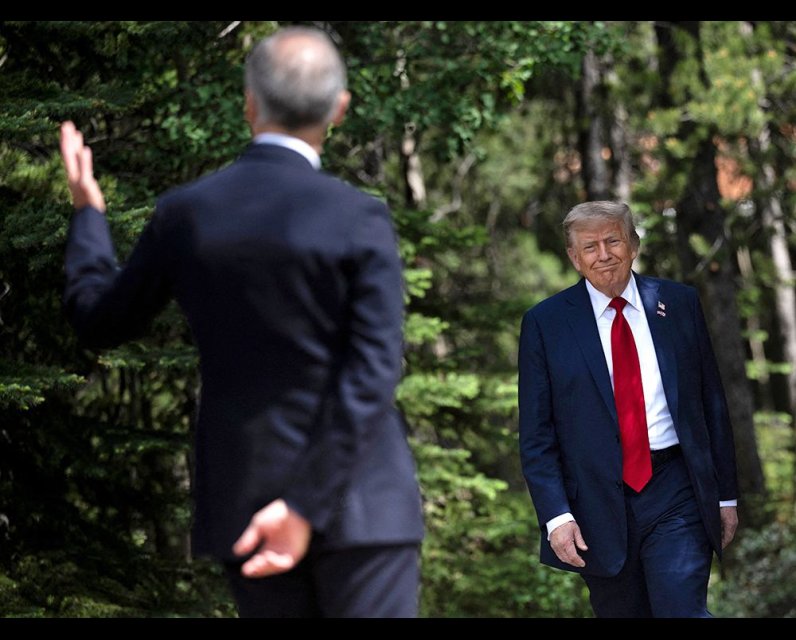Canadians are torn about whether to put their elbows up or down in U.S. trade war: poll

OTTAWA — Canadians are split on whether Canada should go into trade negotiations with the U.S. with elbows up or down when it comes to retaliatory tariffs, according to a new poll.
The Leger/Postmedia poll suggests that 45 per cent of Canadians still believe Canada’s position vis-à-vis U.S. President Donald Trump should be “elbows up.” That means that Canada should impose counter-tariffs on all new U.S. border levies, even if it risks further retaliation from the Trump administration.
But on the other hand, 41 per cent of respondents said they’d prefer Canada’s response be “measured” and focus more on getting a new trade deal even if it includes some tariffs on Canadian goods.
The split among Canadians puts Prime Minister Mark Carney in somewhat of an “awkward position” as he must navigate conflicting views on how to deal with an erratic and unpredictable Trump administration, said Leger executive vice-president Andrew Enns.
On the one hand are those who still believe in the “eye for an eye” approach with the U.S., and on the other hand is the growing number of Canadians who favour a slightly more conciliatory and measured approach.
“I think there’s been a bit of a tempering, a bit of a diminishment of the ‘elbows up’ aggressive approach. It’s still very present, and you know, not to be ignored,” Enns said.
“But I certainly would say that there’s a stronger sort of view now starting to show up in Canadian opinion that says, ‘Well hold on here, maybe we ought to think this through, let’s not be hasty.”
The new survey is in stark contrast to polling just six months ago, when a substantial 73 per cent of respondents told Leger they supported dollar-for-dollar retaliatory tariffs against any U.S. border levy on Canadian goods.
For Enns, it means many Canadians — and particularly Gen Xers and Boomers over 55 years old who expressed particularly fierce Canadian patriotism earlier this year — are having a moment of “sober second thought” as the trade war with the U.S. drags on.
The shift in public sentiment could also be a reflection of the change in tone from Carney himself. During the Liberal leadership race in February, Carney said he supported suggestions of dollar-for-dollar retaliatory tariffs.
But since becoming prime minister, he has not retaliated to any of Trump’s new tariffs on such key Canadian sectors as steel, aluminum and automobiles. In fact, he suggested last week that Canada may remove some tariffs on U.S. imports if it’s beneficial to Canadian industry.
“When we first started to feel the brunt of President Trump’s trade aggression, you know, Canadians were much more bullish, much more aggressive in terms of retaliation,” Enns noted.
“The temperature has come down and you’ve got maybe a bit of sober second thought from Canadians saying that we have to figure out a way out of this and it’s not going to be with ah ‘I hit you, you hit me, I hit you back’ kind of thing.”
Canadians, however, aren’t overwhelmingly supportive of opening specific industries to American competition.
Roughly half the respondents said they were willing to allow American-owned airlines to fly domestic routes in Canada or authorize U.S. telecommunication companies to operate on Canadian soil.
Even fewer (33 per cent) are willing to loosen supply management rules protecting the Canadian dairy industry to let in more U.S. products.
“I would not say there’s a groundswell of support and a sort of blank cheque for Carney, for the prime minister, to open up negotiations on these things,” Enns said. “But it is kind of interesting that there’s about half the population that, all things equal, think ‘I’m open to hearing what that would look like’.”
Carney’s Liberals also appear to have peaked in their popularity with Canadians this summer, the poll suggests.
After months of rising support since the April 28 election, the Liberals’ popularity dipped for the first time, dropping two points to 46 per cent since July 7, the poll says.
But Carney’s party still holds a significant lead over Pierre Poilievre’s Conservatives (36 per cent) and the NDP, led by interim head Don Davies (six per cent), who both saw their parties’ support increase by one point over the past month.
Total satisfaction in the Carney government also dipped slightly by one point though it remains high at 54 per cent.
Enns says it’s too early to say Carney’s honeymoon with Canadians is over, although the data suggest the prime minister may have found his popularity ceiling.
“We may have seen the high watermark for Liberal support, and as we head into the fall and some of these issues start to become more pointed… I would imagine that would be an interesting juncture for the government,” Enns said.
“It wouldn’t surprise me to see a very gradual narrowing of that gap” between Liberals and Conservatives come the fall, he added.
The polling firm Leger surveyed 1,617 respondents as part of an online survey conducted between Aug. 1-4. Online surveys cannot be assigned a margin of error because they do not use random sampling of the population.
National Post
cnardi@postmedia.com
Our website is the place for the latest breaking news, exclusive scoops, longreads and provocative commentary. Please bookmark nationalpost.com and sign up for our politics newsletter, First Reading, here.



Comments
Be the first to comment